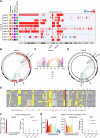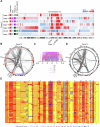CDK4 is co-amplified with either TP53 promoter gene fusions or MDM2 through distinct mechanisms in osteosarcoma
- PMID: 39322633
- PMCID: PMC11424644
- DOI: 10.1038/s41525-024-00430-y
CDK4 is co-amplified with either TP53 promoter gene fusions or MDM2 through distinct mechanisms in osteosarcoma
Abstract
Amplification of the MDM2 and CDK4 genes on chromosome 12 is commonly associated with low-grade osteosarcomas. In this study, we conducted high-resolution genomic and transcriptomic analyses on 33 samples from 25 osteosarcomas, encompassing both high- and low-grade cases with MDM2 and/or CDK4 amplification. We discerned four major subgroups, ranging from nearly intact genomes to heavily rearranged ones, each harbouring CDK4 and MDM2 amplification or CDK4 amplification with TP53 structural alterations. While amplicons involving MDM2 exhibited signs of an initial chromothripsis event, no evidence of chromothripsis was found in TP53-rearranged cases. Instead, the initial disruption of the TP53 locus led to co-amplification of the CDK4 locus. Additionally, we observed recurring promoter swapping events involving the regulatory regions of the FRS2, PLEKHA5, and TP53 genes. These events resulted in ectopic expression of partner genes, with the ELF1 gene being upregulated by the FRS2 and TP53 promoter regions in two distinct cases.
© 2024. The Author(s).
Conflict of interest statement
The authors declare no competing interest.
Figures






References
-
- Gianferante, D. M., Mirabello, L. & Savage, S. A. Germline and somatic genetics of osteosarcoma—connecting aetiology, biology and therapy. Nat. Rev. Endocrinol.13, 480–491 (2017). - PubMed
-
- Baumhoer, D. et al. Osteosarcoma. In: WHO Classification of Tumours Editorial Board. Soft Tissue and Bone Tumours. 5th ed. 403–409 (International Agency for Research on Cancer, 2020).
-
- Beird, H. C. et al. Osteosarcoma. Nat. Rev. Dis. Prim.8, 77 (2022). - PubMed
-
- Yoshida, A., Bredella, M. A., Gambarotti, M. & Sumathi, V. P. Low-grade central osteosarcoma. In: WHO Classification of Tumours Editorial Board. Soft Tissue and Bone Tumours. 5th ed. 400–402 (International Agency for Research on Cancer, 2020).
-
- Wang, J., Nord, K. H., O’Donnell, P. G. & Yoshida, A. Parosteal osteosarcoma. In: WHO Classification of Tumours Editorial Board. Soft Tissue and Bone Tumours. 5th ed. 410-413 (International Agency for Research on Cancer, 2020).
LinkOut - more resources
Full Text Sources
Research Materials
Miscellaneous

